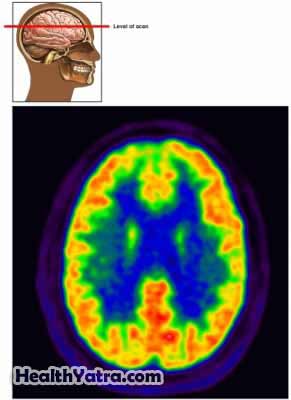Definition
PET/CT scan is a type of imaging test that combines positron emission tomography(PET) and computed tomography (CT) techniques. Combined PET/CT scans can be performed on any part of the body.
PET scans use a radioactive tracer that is introduced into your body to measure the cellular activity of the body part being scanned. A CT scan takes a large number of x-rays. These are analyzed by a computer to create a three-dimensional image of the body part being studied. When both tests are performed at the same time, the information about function and structure is integrated through computer models.

Reasons for Test
Because combined PET/CT scans provide a combination of information about the function and structure of a body part, they are very useful for the early diagnosis of cancer. Not only can the presence of an abnormal tumor be noted, but the function of the cells that make up the tumor can be analyzed. This can help to differentiate between cancerous and noncancerous growths. PET/CT can also be used to see if cancer has spread into other areas of the body.
Each of these tests has its own limitations. When combined, they provide very precise information on cancer location and activity. In the past, both of the tests had to be done separately, making the interpretation of results more difficult due to changes in the patient’s body position. However, with the availability of scanners that combine both technologies, this is no longer a problem. Many cancer specialists believe that this technology will allow doctors to reduce the number of invasive procedures that patients need to undergo and still be able to provide very accurate monitoring.
Brain, endocrine and heart disorders are also studied using PET/CT scans.
Possible Complications
Some possible complications with this test include:
- Allergic reactions to the chemicals used
- Kidney damage from the contrast chemical used
What to Expect
Prior to Test
Prepare a list of medications you are taking; bring the list with you to the test. If you have diabetes, discuss taking your diabetic medications and/or insulin with your doctor prior to the test. An abnormal blood glucose level may interfere with the tests results.
Let your doctor know if you have kidney disease. The doctor may need to take steps to avoid kidney injury during the test.
To prepare for your test, you may need to do the following several hours in advance:
- Not eat anything after a certain time
- Avoid beverages with high sugar and calorie content
- Drink plenty of water
If you are breastfeeding, talk to your doctor before you go for your test. Your doctor may recommend that you pump breast milk ahead of time and use it until the contrast materials are no longer in your body.
At the test center, the talk to the staff if you ever have or had:
- A past reaction to a contrast materials or iodine
- Allergies to contrast materials, iodine, or seafood
- Asthma
- Claustrophobia or anxiety
Description of Test
- If you are anxious about being in enclosed spaces, you may be given a light sedative to help you relax.
- An intravenous (IV) line will be placed in your arm.
- A small quantity of the tracer substance (used for the PET portion of the scan) will be injected through the IV line. In some cases the tracer substance will be inhaled or swallowed rather than injected.
- You will wait about 60 minutes after this injection.
- You will be positioned on a table.
- Another injection of contrast material (used for the CT portion of the scan) will be given.
- The table will move slowly through a doughnut-shaped ring. You will need to lie quite still for about 35 minutes while the PET/CT images are being taken.
After Test
- You should continue to drink extra water throughout the day after your scan. This helps to flush the tracer materials from your body.
- If you have received any sedation, you will need to have someone drive you home.
- You can expect to be able to resume your normal activities the same day as your test.
How Long Will It Take?
A PET/CT scan takes about a total of two hours to complete. The injection occurs about 60 minutes to an hour prior to the start of the scan. The scan itself takes about 35 minutes.
Will It Hurt?
The placement of the IV line may give you some discomfort, but there should be no other pain involved. You may feel some flushing when the tracer material is injected.
Results
Based on the results, your doctor will decide if any further tests or treatments are needed.
Call Your Doctor
Call your doctor if any of the following occurs:
- Signs of allergic reaction, including flushing, hives, and itching
- Swollen or itchy eyes
- Difficulty breathing or a feeling of tightness in your throat
- Nausea
- Less urine than normal
If you think you have an emergency, call for medical help right away.
